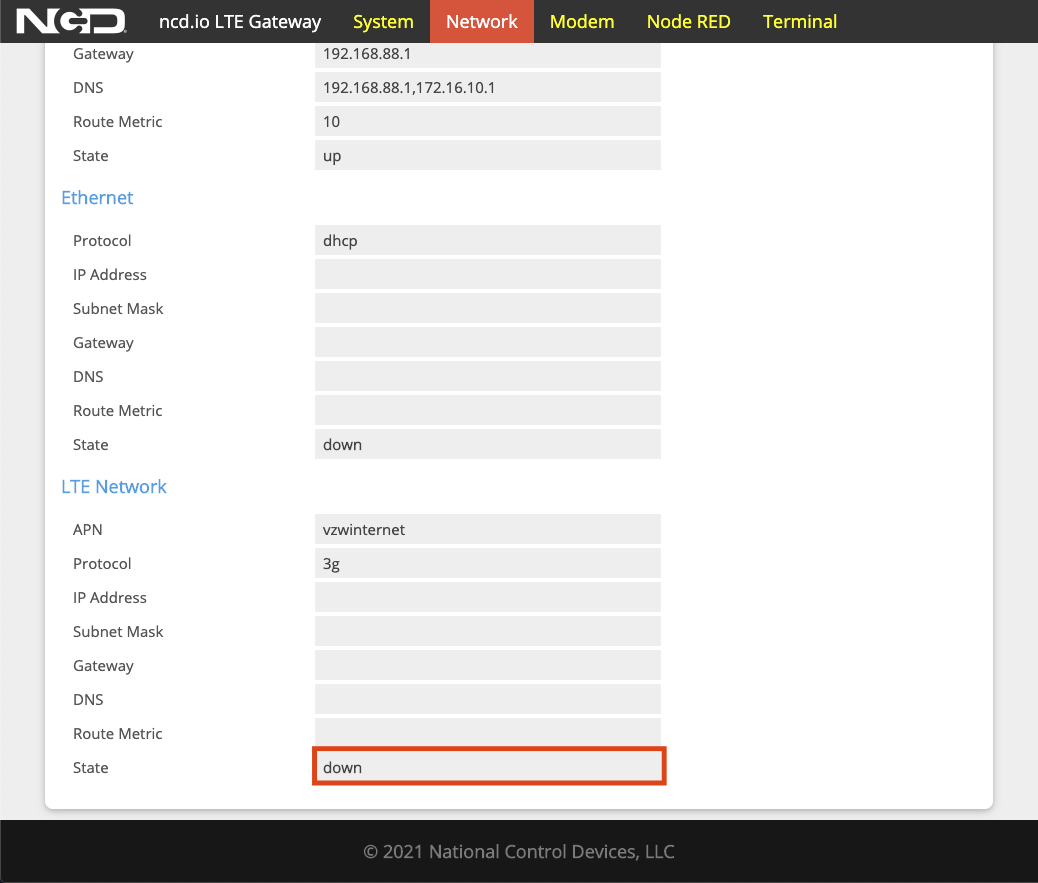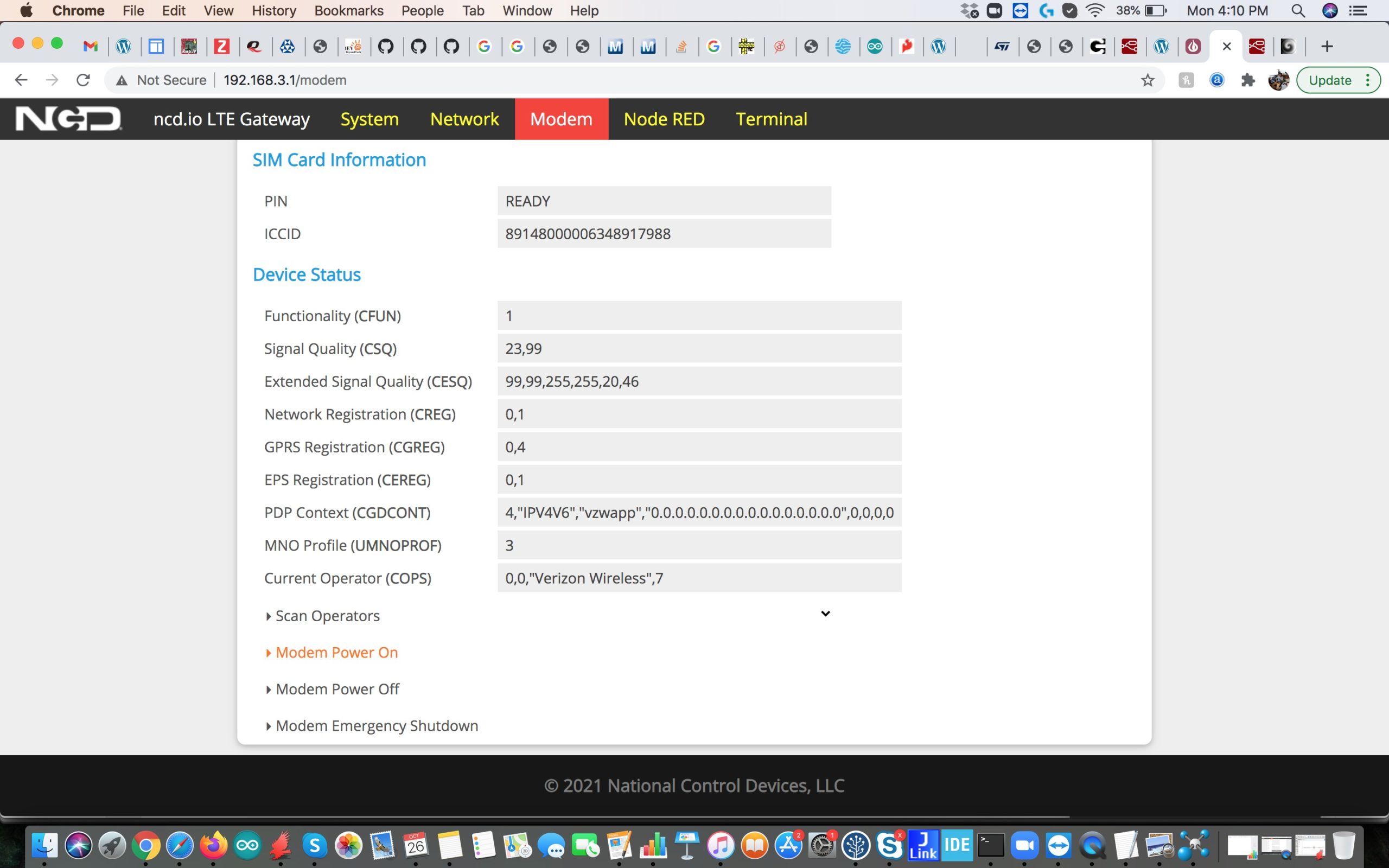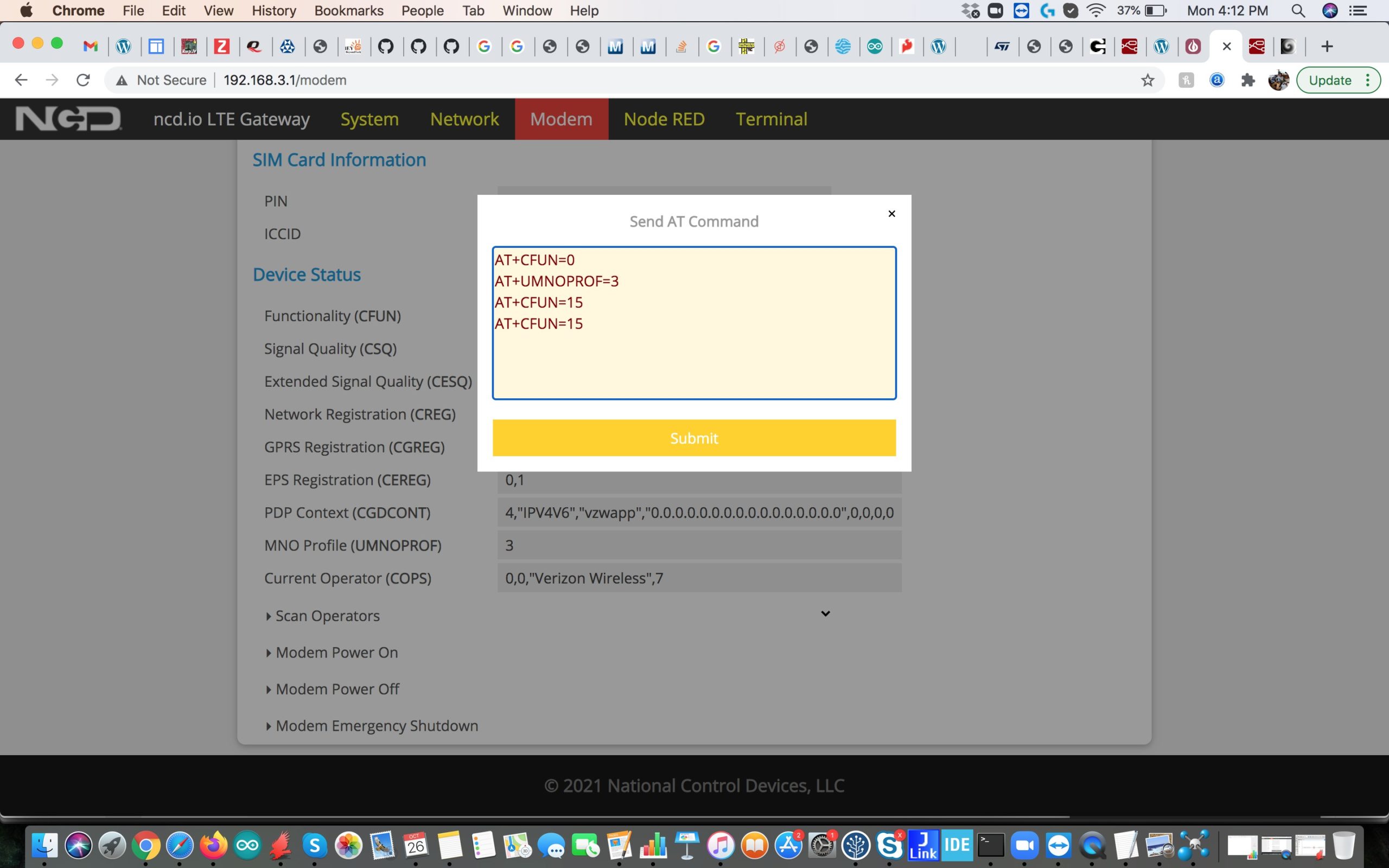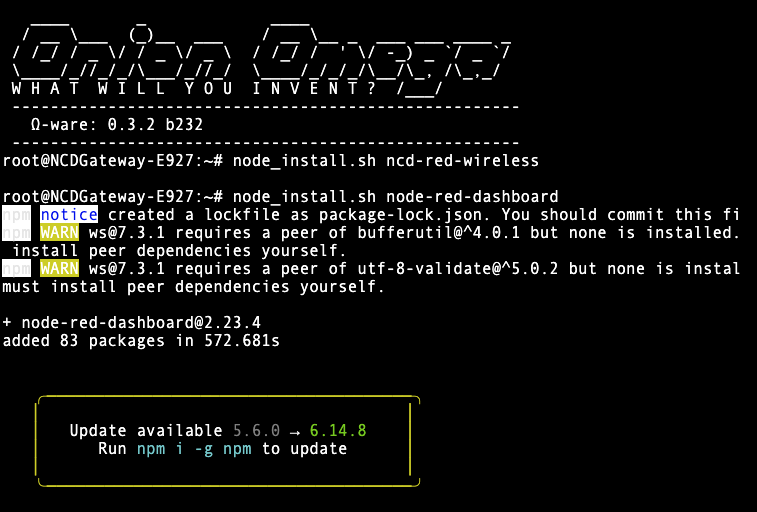LTE Cellular Ethernet WiFi NCD IoT Edge Computer
Introducing NCD’s first IoT edge computer with integrated LTE Cellular, Ethernet, WiFi, and DigiMesh long-range wireless communications. Designed specifically for Node-RED users seeking a Cellular LTE communications solution to connect NCD sensors to multiple cloud platforms. Integrated WiFi and Ethernet communications makes it possible to communicate sensor data over local area networks. Powered by OpenWRT, this linux based computer comes pre-loaded with Node-RED and a NCD sensor parsing flow ready to communicate to a wide array of communication technologies and cloud platforms. The integrated MicroSD card slot makes data logging possible with extra software. Integrated user-programmable Blue 128×64 OLED display makes it possible to display connection status information.
Integrated long-range wireless 900MHz communications is used to collect data from localized NCD sensors up to 2 Miles from the NCD IoT Edge computer. This device is compatible with all NCD sensors using the pre-loaded Node-RED flow. Experienced Node-RED users may push NCD sensor data to Losant, Ubidots, Amazon® AWS®, Microsoft® Azure®, and MQTT using any combination of Cellular LTE, Ethernet, or WiFi. Keep NCD IoT sensor data local using the integrated WiFi or Ethernet connection or use Cellular LTE as a failsafe backup if local network communications is lost. The NCD IoT Edge Computer serves an ideal gateway solution for experienced Node-RED users, offering unparalleled flexibility in configuration for all communication technologies.

Hardware Specifications
This IoT Edge Computer is powered by a Linux based SBC.
- CPU: MediaTek MT7688 580MHz
- Flash: 8GB
- DDR2D: 128MB
- WiFI 2.4 GHz: WEP64/128, AES, WPA, WPA2, WAP
- Ethernet: 10M/100M
- LTE: Ublox SARA-R410M-02B-02 LTE Cat M1 / NB1 / GPRS module
- Supported SIM Cards: Verizon and Hologram
- Long Range Wireless Communications: 900HP-S3B DigiMesh
- OLED: Blue 128×64 Displays Network Info
- MircoSD Card Slot
Software Specifications
The SBC is powered by OpenWrt linux. It comes with preinstalled Node-RED and NCD Node-RED libraries for use with NCD long range wireless sensors. Node-RED is a UI based drag and drop utility which may be used to push sensor data to any cloud service or to view data locally.
This edge computer also supports python and gcc. This allows users to write their own applications when Node-RED is not required. To learn more about Node-RED, check out this article.
The NCD IoT Edge Computer is recommended for experienced Node-RED developers who need a small, low-cost, flexible gateway solution for connecting NCD long range wireless sensors to a variety of networks as well as cloud computing platforms.
We have not placed any hard limits on the number of sensors that may communicate to a NCD IoT Edge Computer.
For Experienced Node-RED Users Only
Node-RED and Linux Experience is REQUIRED to use this device. This is a universal hardware computing platform that can be used for many applications and is not intended to service any particular application without software customization.
Good to Know: Default Settings
- Soft AP Default IP: 192.168.3.1
- Soft AP Password: ncdgateway
- Terminal Username: root
- Terminal Password: ncdio
NCD IoT Edge LTE Cellular Setup
1. Power On the NCD IoT Edge Computer
Once the Edge is powered up, check for nearby WiFi Networks on a local computer equipped with WiFi.
The Edge will publish a Soft AP and will be something like “ncdgateway-XXXX“.
2. Connect to the NCD IoT Edge Computer
Connect to “ncdgateway-XXXX“. The Default Password is ncdgateway.
Once a PC is connected to the soft AP, go to 192.168.3.1 in any web browser.
The soft AP IP address may also be found on the OLED screen.
3. Configure the NCD IoT Edge Settings
Please be aware this UI may be very slow to load the first few times it is used. Please be patient during setup of this device.
The interface displayed will contain a System, Network, Modem, Node-RED, and Terminal tab.
- System, Network, and Modem each contain settings that we are going to configure to our needs.
- The Node-RED tab will open up Node-RED and automatically display a default flow diagram.
- The final tab, Terminal, opens up a new terminal window. This NCD IoT Edge Computer comes with openwrt linux and is pre-loaded with python and gcc.
Note: How to set sim cards
Each sim card provider has its own set of parameters like APN name, MNO Profile, etc. The LTE network tab can be used to set these parameters. When using hologram, set the APN to “hologram”. In the case of Verizon, use the APN name “vzwinternet”.
Note: Setting Communication Route Priorities
The NCD IoT Edge computer includes three hardware communication options. Users may set priorities for communication technologies in any order using the Route Metric parameter. The Route Metric cannot be set if the communication status is down. If the communication status is Up, users may enter any value between 0 and 100 whereby 0 is the highest priority for network communications and 100 is the lowest priority for network communications. NCD recommends setting the Ethernet Route Metric to the lowest value for highest priority.
Supported LTE Cellular Networks
By default the NCD IoT Edge Computer is set to work with “hologram”. if Verizon Sim Card is preferred, modify the parameters shown below.
Good to Know: Optional Steps Shown Below
Complete steps 3B - 3E ONLY when using a Network Provider other than Hologram. Otherwise, skip to step 4.
Setting up LTE Service Provider
Due Open source nature of this devices, users have choice to use their own SIM card. ncd tests LTE gateway with Hologram and Verizon sim cards.
Setting with verizon is extremely simple and can be done through web ui.
Step 1- Select the APN ( vzwinternet)


Step 2- Select the correct UMNOPROF
A. click change Modem profile

B. Select profile 3

NOTE – Due to security reasons, In order to use with Verizon, share your LTE IMEI number with ncd support staff. This IMEI should be registered with Verizon in order to authorized SIM card with LTE modem.
3C. Change LTE Cellular Network Provider
The LTE modem used in this product is SARA-R410M-02B. It supports most of the cellular networks out there. users are free to choose and modify any settings of the modems.
Open the Terminal from the top right tab and enter the login credentials.
Login: root
Password: ncdio
The NCD IoT Edge Computer comes with openwrt linux and is pre-loaded with python and gcc. Users can write their own application if they do not wish to use Node-RED.
3D. Ensure the Modem Settings are updated
Click on the Modem Tab. Wait for a few seconds to see if the user interface populates data.
If these settings do not update and display information, issue a Modem Power ON command as indicated to the right.
Wait for roughly 30-40 seconds and reload the screen by either clicking the Modem Tab again, or refreshing the page.
If this does not work, unplug the power from the device and plug it back in (being sure to reconnect to the NCD IoT Edge Computer network and search the IP Address again after powering the NCD IoT Edge Computer back on).
Repeat this process until the data is finally populated on the UI. As mentioned before, this initial process can be slow. Be prepared to possibly spend several minutes on this step retrying the above process.
Note: For Verizon
These settings are not required when using a Hologram sim card.
After Modifying Modem parameters, a power cycle may be required if the UI does not update after submitting the new MNO Profile for Verizon.
3G. Singtel SIM card Setup
Step 1 — Set the UMNOPROF profile to 0
Step 2 — Make a copy the hologram.chat and save it as singtel.chat
Step 3 — Edit singtel.chat to match the image
Line 14 — OK AT+CGDCONT=1,”IP”,”e-ideas”
Step 4 — Go to Network tab and select singtel as APN Singtel
3H. Eastlink SIM card Setup
Step 1 — Set the UMNOPROF profile to 0
Step 2 — Make a copy the hologram.chat and save it as Eastlink.chat
Step 3 — Edit Eastlink.chat to match the image
Line 14 — OK AT+CGDCONT=1,”IP”,”wisp.mobi.eastlink.ca”
Step 4 — Go to Network tab and select Eastlink as APN
4. Node-RED
After configuring the NCD IoT Edge Computer properly, follow the directions below to help get started:
Node-RED is a UI based drag and drop solution. It can be used to view data locally or push sensor data to AWS®, Azure®, or MQTT. Node-RED also allows users to store data on a local database as well as send email and test alerts.
The NCD IoT Edge Computer comes with Node-RED pre loaded and also comes with a few example flows which can be used to push data to MQTT and AWS®.
One of the most powerful features of the NCD IoT Edge Computer is that it runs Node-RED. This allows users to use any cloud and any local computer for localized sensor processing.
User can install any node red lib using this command node_install.sh “node package name”
To know more about node red checkout this post.
5. Installing node red libraries
The libraries below are already installed on the NCD IoT Edge Computer. However the libraries may be updated in the terminal.
Should a library update be required, run these two commands in the UI terminal and apply the update command when prompted.
node_install.sh ncd-red-wireless
node_install.sh node-red-dashboard
6. Firmware Update
In the case that the NCD IoT Edge Computer needs factory reset, checkout the below instructions
Factory reset could take few minutes. During the factory reset it will reboot couple of times.
Next, navigate to the NCD Github files. Download and copy these files in a USB driver. Inset this USB driver into Edge Device. This will ensure that the NCD IoT Edge Computer is up to date with the latest files.
Make sure Ethernet is up and running in the Edge Device.
. Follow these steps
- connect gateway to PC via USB
- open serial port using command terminal
- Make sure Ethernet is connected and working
open terminal ( default baudrate 115200)
firstboot -y
reboot
go to cd /mnt/sda1
run ./setup.sh
7. Disable Soft AP WiFi
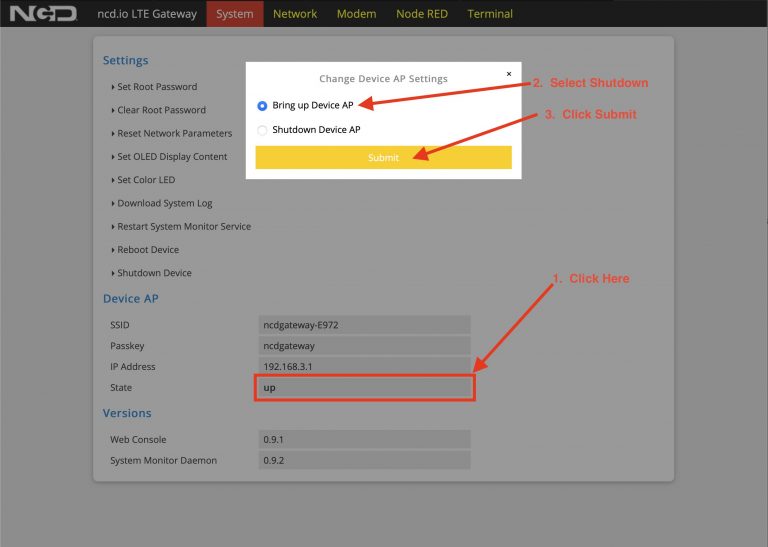
Debug Notes
If everything looks good but the NCD IoT Edge Computer still doesn’t work or has connection problems, we recommend checking the following parameters:
- Ensure the NCD IoT Edge Computer is powered up
- Ensure it has a SIM card and is inserted correctly
- Ensure SIM card is active and has a balance in it (user has to activate the sim card)
- Ensure Antenna is connected at the correct Spot
- Ensure APN and UMNOPROF are set correctly
- Ensure the installation location has good cellular connectivity
- Bring up the LTE Network command (using the web UI, next go to LTE Network Tab) and give it time to scan and connect to the network.
Good to Know: Open Source Software
The NCD IoT Edge Computer is based on Open Source software. While some software has been developed by NCD to add NCD IoT Edge functionality, all related warranties are limited to the NCD IoT Edge Computer hardware only (which is not open source). NCD is not selling open source software in any way. NCD staff will assist users in obtaining the full source code if needed, please contact NCD technical support via our online forum for any software resources that may be required, NCD staff will post links and resources publicly for the benefit of all customers.
Modem AT commands
In order to access the LTE modem over serial make sure the LTE network is disabled.
- Open terminal
- picocom -b115200 /dev/ttyS2

Some AT test Commands
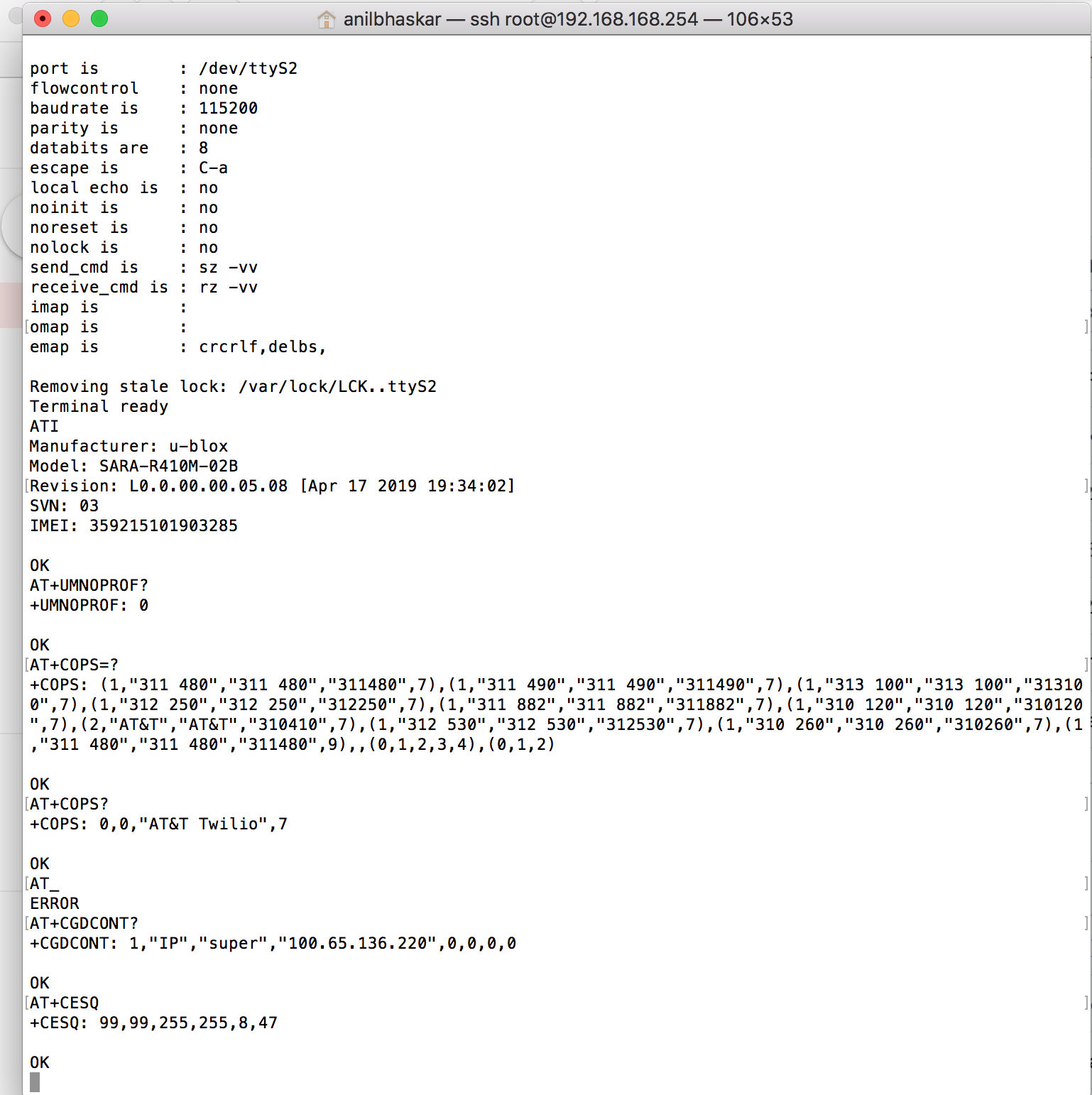
Update Node Red
node red can be updated using following commands. Make sure the device has internet connectivity over wither WiFi or Ethernet.
opkg update
opkg upgrade onion-node-red
Add 3rd party SIM cards
The LTE modem is certified to be used worldwide. In order to enable the SIM card, there are two parameters whihc needs to checked
- APN Name – The APN name can be modified by editing the chatscripts.
AT+CGDCONT=2,”IPV4V6″,”super”
Check with your SIM card provider for CID value ( in above case its 2, the default value is 1) and APN name.
2. UMNOPROF value – It can be modified be editing the profiles. The default value is 0. Some SIM card provider have recommend different values. Example

Note : We have seen that prepaid sim cards work alot better than postpaid. We recommend that users use Industrial IoT sim cards instead regular phone SIM cards.




